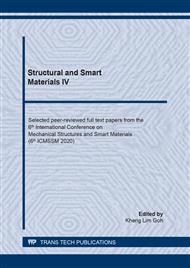[1]
Weiping Liu, J.N. Dupont. Effect of melt pool geometry on crystal growth and microstructure development in laser surface-melted superalloy single crystals. Mathematical modeling of single-crystal growth in a melt pool (Part I),Acta Materialia. 52(2004), 4833-4847.
DOI: 10.1016/s1359-6454(04)00390-8
Google Scholar
[2]
Weiping Liu, J.N. Dupont. Effect of substrate crystallographic orientations on crystal growth and microstructure development in laser surface-melted surperalloy single crystals. Mathematical modeling of single-crystal growth in a melt pool (Part II),Acta Materialia.53(2005),1545-1558.
DOI: 10.1016/j.actamat.2004.12.007
Google Scholar
[3]
M.Rappaz S.A. David, J.M. Vitek, L.A, Boatner. Development of microstructures in Fe-15Ni-15Cr single crystal electron beam welds, Metallurgical Transactions A. Vol.20A(6) (1989), 1125-1138.
DOI: 10.1007/bf02650147
Google Scholar
[4]
M.Rappaz S.A. David, J.M. Vitek, L.A. Boatner. Analysis of solidification microstructures in Fe-Ni-Cr single-crystal welds, Metallurgical Transactions A. Vol.21A(6) (1990),1767-1782.
DOI: 10.1007/bf02672593
Google Scholar
[5]
M.Rappaz, Ch.A. Gandin. Probabilistic modeling of microstructure formation in solidification processes, Acta Metal.Mater. Vol.41(2) (1993),345-360.
DOI: 10.1016/0956-7151(93)90065-z
Google Scholar
[6]
T.D. Anderson, J.N. Dupont, T.Debroy. Origin of stray grain formation in single-crystal superalloy weld pools from heat transfer and fluid flow modeling, Acta Materialia. 58(2010), 1441- 1454.
DOI: 10.1016/j.actamat.2009.10.051
Google Scholar
[7]
T.D. Anderson, J.N. Dupont, T.Debroy. Stray grain formation in welds of single-crystal Ni-based superalloy CMSX-4, Metallurgical and Materials Transaction A.Vol.41A(1) (2010),181-193.
DOI: 10.1007/s11661-009-0078-9
Google Scholar
[8]
J.M. Vitek. The effect of welding conditions on stray grain formation in single crystal welds-theoretical analysis, Acta Materialia. 53(2005),53-67.
DOI: 10.1016/j.actamat.2004.08.039
Google Scholar
[9]
J.W. Park, S.S. Babu, J.M. Vitek, E.A. Kenik, S.A. David. Stray grain formation in single crystal Ni-based superalloy welds, Journal of Applied Physics. Vol.94(6) (2003),4203-4209.
DOI: 10.1063/1.1602950
Google Scholar
[10]
D.Dye, O.Hunziker, R.C. Reed. Numerical analysis of the weldability of superalloys, Acta Mater. 49(2001),683-697.
DOI: 10.1016/s1359-6454(00)00361-x
Google Scholar
[11]
O Hunziker, D.Dye, R.C. Reed. On the formation of a centerline grain boundary during fusion welding, Acta Mater. 48(2008),4191-4201.
DOI: 10.1016/s1359-6454(00)00273-1
Google Scholar
[12]
N.Wang,S.Mokadem,M.Rappaz, W.Kurz. Solidification cracking of superalloy single- and bi-crystals, Acta Materialia. 52(2004),3173-3183.
DOI: 10.1016/j.actamat.2004.03.047
Google Scholar
[13]
M.Gaumann,C.Bezencon,P.Canalis,W.Kurz. Single-crystal laser deposition of superalloys: processing-microstructure maps, Acta Mater. 49(2001),1051-1062.
DOI: 10.1016/s1359-6454(00)00367-0
Google Scholar
[14]
R.J. Moat, A.J. Pinkerton, L.Li, P.J. Withers, M.Preuss. Crystallographic texture and microstructure of pulsed diode laser-deposited Waspaloy, Acta Materialia. 57(2009),1220-1229.
DOI: 10.1016/j.actamat.2008.11.004
Google Scholar
[15]
A.de Bussac, Ch.A. Gandin. Prediction of a process window for the investment casting of dendritic single crystals, Materials Science and Engineering A. 237(1997),35-42.
DOI: 10.1016/s0921-5093(97)00081-6
Google Scholar
[16]
A.Wagner B.A. Shollock, M.Mclean. Grain structure development in directional solidification of nickel-based superalloy, Materials Science and Engineering A. 374(2004),270-279.
DOI: 10.1016/j.msea.2004.03.017
Google Scholar
[17]
X.L. Yang, H.B. Dong, W.Wang, P.D. Lee. Microscale simulation of stray grain formation in investment cast turbine blades, Materials Science and Engineering A. 386(2004),129-139.
DOI: 10.1016/s0921-5093(04)00914-1
Google Scholar
[18]
Zhang Weiguo, Liu Lin, Huang Taiwen, Zhao Xinbo. Influence of directional solidification variables on primary dendrite arm spacing of Ni-based superalloy DZ125,China Foundry. Vol.6(4) (2009),300-304.
Google Scholar
[19]
M.Qian J.C. Lippold. The effect of annealing twin-generated special grain boundaries on HAZ liquation cracking of nickel-based superalloys, Acta Materialia. 51(2003),3351-3361.
DOI: 10.1016/s1359-6454(03)00090-9
Google Scholar
[20]
M.Qian J.C. Lippold. The effect of multiple postweld heat treatment cycles on the weldability of Waspaloy, Welding Journal. 11(2002),233s-238s.
Google Scholar
[21]
Akin Odabasi, Necip Unlu, Gultekin Goller, Mehmet Niyazi Eruslu. A study on laser beam welding (LBW) technique: effect of heat input on the microstructure evolution of superalloy Inconel 718,Metallurgical and Materials Transactions A, Vol.41(9) (2010),2357-2365.
DOI: 10.1007/s11661-010-0319-y
Google Scholar
[22]
J.K. Hong, J.H. Park, N.K. Park, I.S. Eom. Microstructures and mechanical properties of Inconel 718 welds by CO2 laser welding, Journal of Materials Processing Technology.201(2008), 515-520.
DOI: 10.1016/j.jmatprotec.2007.11.224
Google Scholar
[23]
Edward H. Kottcamp. ASM Handbook, Volume 3, Alloy phase diagrams, ASM International, USA,1993,49-155.
Google Scholar
[24]
Wu Qiong, Li Shusuo, Ma Yue, Gong Shengkai. First principles calculations of alloying element diffusion coefficient in Ni using the five-frequency model, Chin. Phys. B.Vol. 21(10) (2012), 1091021-1-7.
DOI: 10.1088/1674-1056/21/10/109102
Google Scholar


